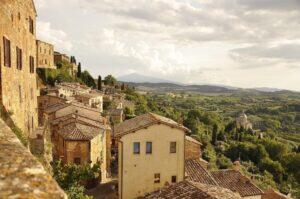Fodor's Expert Review Sacro Eremo e Monastero di Camaldoli
In 1012, four centuries after the founding of the Benedictine order, St. Romualdo—feeling that his order had become too permissive—came to the forests of the Casentino and found their remoteness, beauty, and silence more conducive to religious contemplation. He stayed and founded this hermitage, which was named for Count Maldoli, who donated the land, and which became the seat of a reformed Benedictine order. An important requirement of the new order was preserving its ascetic atmosphere: "If the hermits are to be true devotees of solitude, they must take the greatest care of the woods." When the flow of pilgrims began to threaten that solitude, Romualdo had a monastery and hospital built down the mountain to create some distance.
Today, you can view the hermitage—where the monks live in complete silence in 20 separate little cottages, each with its own walled garden—through gates and visit the church and original cell of Romualdo, the model for all the others. The church,... READ MORE
In 1012, four centuries after the founding of the Benedictine order, St. Romualdo—feeling that his order had become too permissive—came to the forests of the Casentino and found their remoteness, beauty, and silence more conducive to religious contemplation. He stayed and founded this hermitage, which was named for Count Maldoli, who donated the land, and which became the seat of a reformed Benedictine order. An important requirement of the new order was preserving its ascetic atmosphere: "If the hermits are to be true devotees of solitude, they must take the greatest care of the woods." When the flow of pilgrims began to threaten that solitude, Romualdo had a monastery and hospital built down the mountain to create some distance.
Today, you can view the hermitage—where the monks live in complete silence in 20 separate little cottages, each with its own walled garden—through gates and visit the church and original cell of Romualdo, the model for all the others. The church, rebuilt in the 13th century and transformed in the 18th to its present appearance, strikes an odd note in connection with such an austere order and the simplicity of the hermits' cells, because it's done up in gaudy baroque style, complete with gilt cherubs and a frescoed vault. Its most appealing artwork is the glazed terra-cotta relief Madonna and Child with Saints (including a large figure of Romualdo and a medallion depicting his fight with the devil) by Andrea della Robbia. The main entrance to the hermitage, the bronze Porta Speciosa (Beautiful Door) of 2013, by Claudio Parmiggiani (born in 1943), has an inscription on its inner side that likens the monks' spirits to the trees that they tend.
Within the Monastero di Camaldoli, 3 km (1 mile) away, is a church (repeatedly restructured) containing 14th-century frescoes by Spinello Aretino, seven 16th-century panel paintings by Giorgio Vasari, and a quietly lovely monastic choir. The choir has 18th-century walnut stalls, more Vasari paintings, and a serene fresco (by Santi Pacini) of St. Romualdo instructing his white-robed disciples. In a hospital built for sick villagers in 1046, the 1543 Antica Farmacia (Old Pharmacy) contains original carved walnut cabinets. Here you can buy herbal teas and infusions, liqueurs, honey products, and toiletries made by the monks from centuries-old recipes as part of their daily routine balancing prayer, work, and study (the monastery is entirely self-supporting). In the back room is an exhibit of the early pharmacy's alembics, mortars, and other equipment with which the monks made herbs into medicines. You can attend short spiritual retreats organized by the monks throughout the year; contact the foresteria (visitors lodge) for details.
READ LESS





